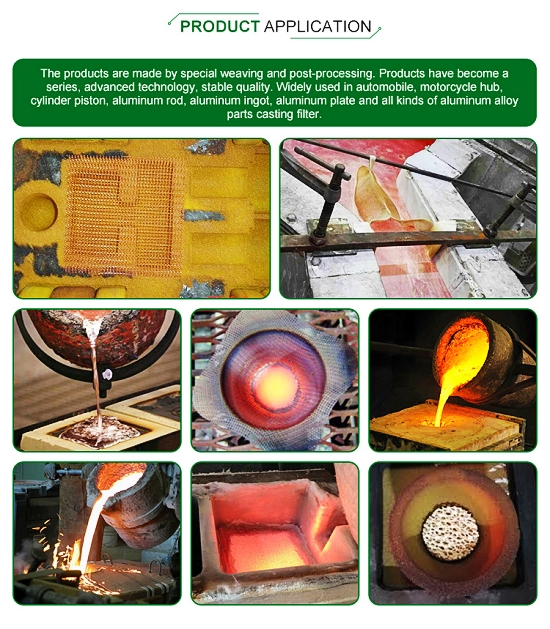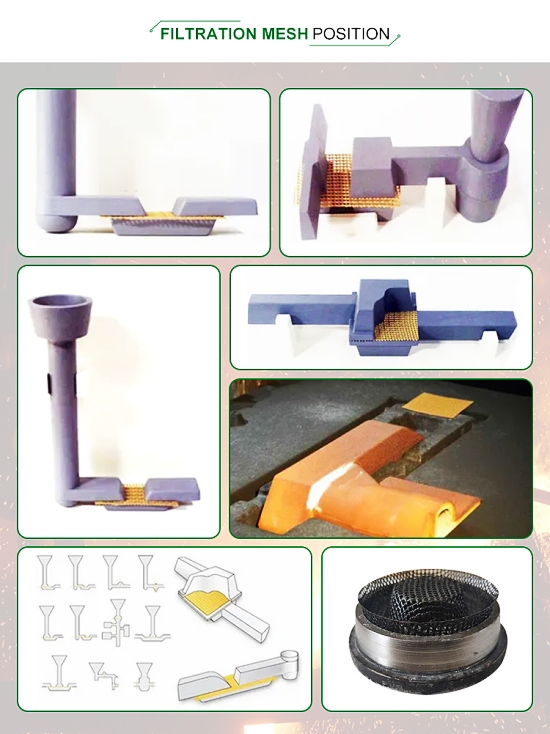Dec. 09, 2024
Fiberglass filter mesh is made of various materials fiberglass cloth by impregnating resin and other bonding materials. The main function is to block macroscopic inclusions into the cavity, and slightly adsorb small inclusions.
Classification:
● According to the different scope of use, it can be divided into steel filtration, ironfiltration, copper filtration, and aluminum filtration.
● According to the different shapes, it can be divided into flake, round, spherical, cap, barrel, etc.
● According to the different materials used, it can be divided into alkali-free mesh cloth, medium alkali mesh cloth, high silicon oxygen mesh cloth and other filters.
Non-alkali mesh is generally used for casting aluminum, high silicon oxygen mesh is usually used for casting iron and steel.

In casting production, the casting waste rate can be reached to be 50 to 60% of the total amount of waste due to non-metallic inclusions and other casting problems.
The inclusions do not only reduce mechanical properties of the casting, but also has a great influence on processability and appearance.
For the purification of liquid casting alloys, it is an important technical measure to obtain good quality castings that reducing or filtering various non-metallic inclusions. So, the casting filter mesh has become an important auxiliary material for purification of liquid casting alloys.
At present, a large number of manufacturers use metallic barbed wire as a filter material, but due to the presence of a large amount of iron elements, the blanks waste parts containing the filter, gate and riser can only be treated as waste aluminum.
But aluminum liquid filtered by Fiberglass mesh filter can be directly returned to the furnace for remelting, which greatly improves the reuse rate of waste aluminum and reduces the cost.

1. The use of filters can improve the mechanical properties of the castings, increase the hardness of the castings, make the surface hardness uniform and improve the bending strength of the castings. Change the graphite morphology of the casting, so that the graphite size is reduced, the thickness is thinner, and the shape is slightly curved. Change the machining performance of castings and improve the processing efficiency.
Main varieties are: aluminum, molten iron, molten steel, copper filter, casting filter, etc., to improve the mechanical properties of castings.
2. Change the machining performance of castings and improve the processing efficiency.
Compared with various filters, the high temperature resistant fiberglass filter mesh does not affect the composition of aluminum alloy. The filtering effect is better because itself has the effect of adsorbing impurities.
Because the casting filter mesh has the advantages of high temperature resistance, good mesh stability, convenient use, etc., it is also conducive to the recycling of molten metal waste (the mesh is floated on the surface of the aluminum solution after the waste is returned to the furnace).
High temperature resistant fiberglass filter cloth is an ideal filter material for high-grade aluminum alloy castings.
3. In casting production, there are some quality problems of slag holes, sand holes, and gas holes for steel castings, iron castings, aluminum castings and other alloy castings due to various reasons. So, are prone to quality problems such as slag holes, sand holes, and gas holes due to various reasons.
Therefore, there are great technical value and economic value for improving casting yield and quality that the non-metallic inclusions in the metal melt are removed.
1. First of all, Choose the placement position of fiberglass filter mesh:
there are three main placement positions:
● one is placed at the top of the sprue under the sprue cup,
● the second is placed at the lap of the cross sprue,
● the third is placed at the corner contact between the cross sprue and the inner sprue.
2. Place filter mesh on the parting surface:
there are two placing ways,
● one is horizontal placement, also can be said to be parallel placement, the filter is placed horizontally under the crossmouth cup or parting surface, the casting height should not exceed 20 cm, the metal liquid is washed at the intersection cup wall, not directly to the filter mesh;
● The other is vertical placement.
3. The filter mesh is placed on the top, and the bending surface should be kept upward and flattened from the center to the four sides. At the same time, the filter mesh can not have wrinkles.
4. After aluminum is melted in the smelter, it will be slagged and degassed until it meets the casting requirements, and then it can be out of smelter. The general temperature when coming out is 720℃~730℃. The qualified aluminum liquid is filtered through the flow tank and then poured into the semi-continuous casting crystallizer.
5. In order to ensure that the aluminum melt has sufficient fluidity, the temperature of the liquid aluminum is usually appropriately increased by 3 to 5 ° C (compared with the unfiltered), and the temperature is generally controlled above 680 ° C, but it can not be too high.
6. The aluminum liquid should have a certain initial pressure to ensure that the aluminum melt smoothly passes through fiberglass filter mesh, and the initial pressure is 100 to 150 mm.

● Rectifier mechanism: The filter is placed in the pouring process, the metal liquid is increased the resistance during pouring, changes the flow state, and makes the metal liquid slowly flow into the cast cavity, which is not easy to bring eddy current, the filling is stable, the secondary oxidation and slag inclusion are reduced, which is conducive to the floating of inclusions and the slag blocking function of the pouring system.
● Mechanical filtration: There are a large number of inclusions in liquid metal, slag and other large impurities, through the selection of suitable aperture filter to filter out inclusions larger than the aperture size by mechanical methods.
● Double filtration: During the mechanical filtration, the filter net captures many inclusions larger than the aperture and with the increase of the number of inclusions, the double filtration is formed at the entrance of the filter screen. The double filtration make the liquid metal flow fine and have the function of filtering. The liquid metal can be filtered twice.
● Adsorption: The filter mesh has a large specific surface area, the liquid metal flow through the filter is divided into a small liquid flow unit, then the contact area of the liquid metal and the filter medium is increased. The chemical reaction between harmful elements and oxides in the metal melt and the filter surface is adsorbed on the filter mesh surface.
Contact Us
+86 158 3011 4065
Guoruiyuan Building, ShengLi North Street, Chang'An District, Shijiazhuang City, Hebei Province, China.
Navigation
Navigation
